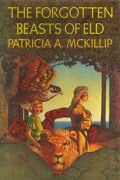

In her studies, Sybel accidentally calls fear itself, which manifests as a horrible bird of prey, the Blammor. There is actually something quite profound here. Like the rest of McKillip's work, this isn't just escapist medieval fantasy with dragons and bards and battles.

But when Sybel is hurt by another magician, she descends from her mountain into the wars of men, and begins to plot her revenge. Sybel refuses to be drawn into the politics of war, although both sides woo her for her powers. But the House of Sirle, who brought Tam to Sybel, also have plans for the boy.

Tam learns that his father is Drede the king. But the two countries below, whose war caused the child to be sent up the mountain, are restless. Tamlorn grows strong and happy on Eld Mountain with Sybel and her animals. She learns to love young Tamlorn and Maelga, the old witch who helps her care for him. Everything changes for Sybel at that point.

Sybel does not know what it means to love, until one day a tired soldier appears on her doorstep carrying a baby - her nephew. Her only desire is to call the fabled Liralen bird to her house, but she cannot find it. Sybel lives alone with her creatures - Gules Lyon, the Cat Moriah, the Bull Cyrin, the Dragon Gyld, and the Falcon Ter. Sybel is a daughter and granddaughter of wizards who learned to call mythical creatures and control them, deep in the forest of Eld Mountain. Patricia McKillip has long been a favorite fantasy author of mine, and this stand-alone story is a great introduction to her work. Parts of Forgotten Beasts felt rushed and in places, I would have liked more "story" around the details. McKillip may not have intended this novel to become an avenue of self-exploration but that is what developed for me.As I say, it was an imaginative story and I would have loved to read more about the 'wizardlings' and hoped for additional interactions with the wondrous beasts. I find thoughtful concepts develop in my own mind about implications for living/not living alone, for the greater harm/benefits of hate and revenge and letting go. I like the way mood is developed as much as action in this narrative style. But the story was so completely unfamiliar that I'm now doubtful I ever read it before.Anyway, it was a nice segue back into the comfortable style of 1970's and 80's fantasies. I'm confounded by the thought I had originally read this when my younger daughter was accumulating YA novels. There are nearly 50 reviews of this story (on LT), and I probably don't have much extra to add.


 0 kommentar(er)
0 kommentar(er)
